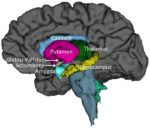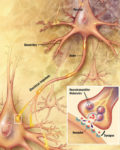
Changes in how the brain processes memories of pleasurable or rewarding experiences contribute to addiction and depression. A study in mice by LeGates and colleagues provides clues to how the brain processes and remembers rewards, which is key to understanding and treating these mental health disorders. They used light-activated proteins (optogenetics) to alter the strength of the signal between two parts of the brain, the hippocampus and the nucleus accumbens (Figure 1). This is one part of a larger circuit in the brain that is involved in processing rewards. Rewards are any experience that is perceived as positive or pleasurable, such as eating good-tasting food, being with friends, or participating in enjoyable activities.

Neurons signal through specialized connections called synapses (Figure 2). Some synaptic connections can become persistently stronger and some can become persistently weaker, a process referred to as synaptic plasticity. When synapses become persistently strengthened, the cellular process is called long-term potentiation; when they become persistently weaker, the process is called long-term depression.
LeGates and colleagues engineered mice to have light-activated proteins in neurons that connected the hippocampus and the nucleus accumbens. When they exposed these neurons in moving, awake mice to a specific wavelength of light for just a few seconds, the light-activated proteins were turned on. If the light-activated proteins triggered long-term potentiation of the synapses, then the mice acted as though they had experienced something rewarding. This “artificial” memory led the mice to repeatedly visit the place where they had experienced the light.
In the opposite experiment, the researchers used a different light-activated protein to inhibit the activity of the neurons so that the neurons did not exhibit long-term potentiation when the mice experienced something that is normally rewarding. These mice no longer showed a preference for a place where they had experienced a reward, in this case interacting with another mouse. Thus, silencing this pathway impaired the processing of rewards.
The researchers hypothesized that depression can result from a similar type of impairment in synaptic plasticity between these two regions of the brain. To test this hypothesis, they evaluated the activity of this part of the brain in mice that had experienced chronic stress and showed depression-like behaviors. In these animals, the communication between the hippocampus and nucleus accumbens was weak. This pathway in the depressed, stressed mice could not be persistently activated by the light-activated proteins to create the artificial reward memories. However, treating the mice with the antidepressant fluoxetine restored the ability of the stimulating light-activated protein to create artificial memories, produced long-term potentiation of the synapses, and alleviated the behavioral symptoms of depression. For example, the mice preferred sugar water to plain water again.
There are likely many neurological causes of depression. This study identifies impaired formation of a type of synaptic plasticity between two regions of the brain that process pleasure as a possible source of depression. Furthermore, this study suggests that patients with depression caused by loss of long-term potentiation in neurons connecting the hippocampus and nucleus accumbens would be responsive to traditional antidepressants. This kind of information may eventually enable screening patients so that doctors can identify those most likely to benefit from a particular treatment strategy.
Highlighted Article
T. A. LeGates, M. D. Kvarta, J. R. Tooley, T. C. Francis, M. K. Lobo, M. C. Creed, S. M. Thompson, Reward behaviour is regulated by the strength of hippocampus–nucleus accumbens synapses. Nature (2018) DOI: 10.1038/s41586-018-0740-8. Full Text PubMed
Related Resources
Scott M. Thompson Faculty Profile at the University of Maryland School of Medicine http://www.medschool.umaryland.edu/profiles/Thompson-Scott/ (accessed 3 December 2018)
2-Minute Neuroscience: Nucleus Accumbens. Neuroscientifically Challenged https://www.youtube.com/watch?time_continue=14&v=3_zgB19TE-M (accessed on 2 December 2018)
C. Yue, Reward Pathway in the Brain. Khan Academy. https://www.youtube.com/watch?v=YzCYuKX6zp8 (accessed 2 December 2018)
N. R. Gough, Discovering fast-acting treatments for depression. BioSerendipity (11 January 2019) https://www.bioserendipity.com/discovering-fast-acting-treatments-for-depression/.
Cite as: N. R. Gough, Giving Mice Artificial Memories to Discover Clues to Depression. BioSerendipity (3 December 2018) https://www.bioserendipity.com/clues-to-depression/

